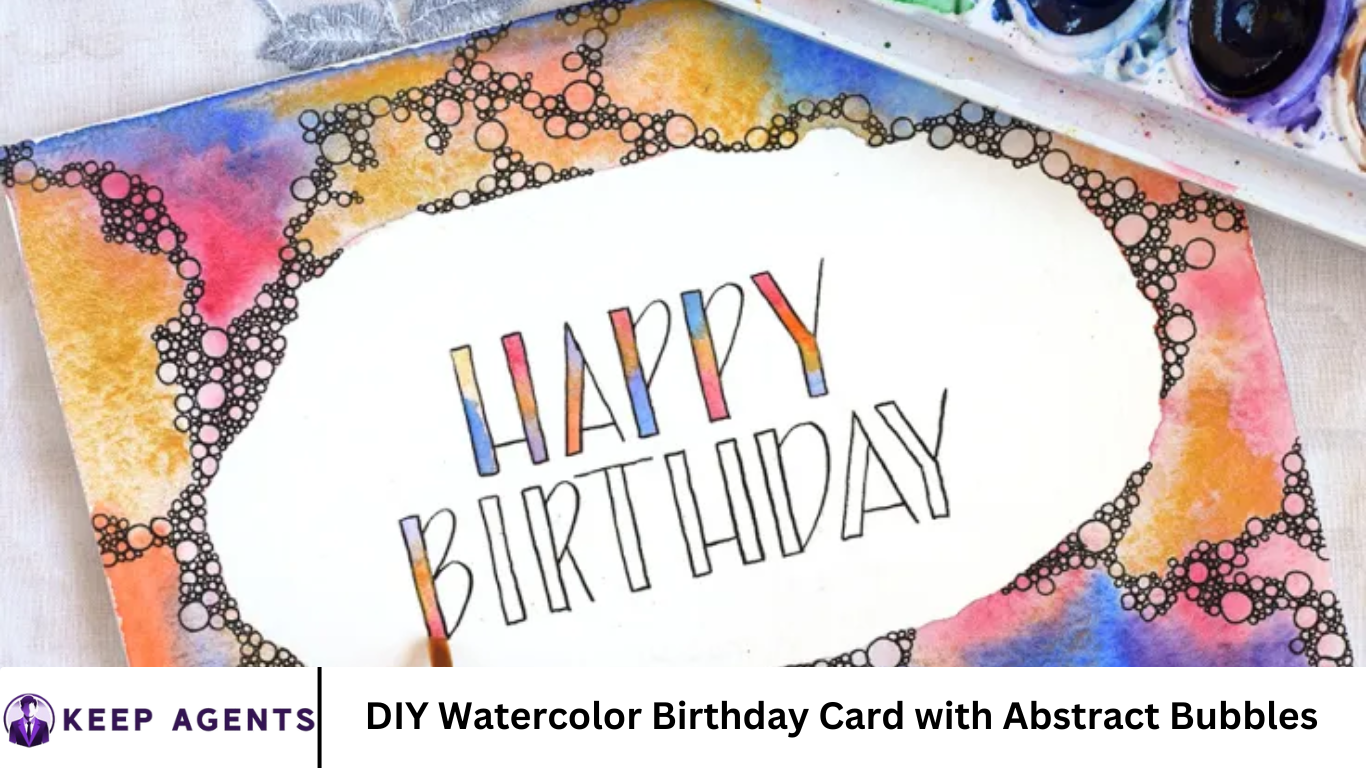There’s nothing quite as special as giving someone a handmade birthday card. It shows care, creativity, and thoughtfulness — qualities that make any birthday more memorable. If you’re looking for a fun, artistic way to celebrate, creating a DIY watercolor birthday card with abstract bubbles is an excellent choice.
This tutorial will guide you through everything you need to know to make your own unique, colorful card that bursts with personality.
More Read: How to Frame and Hang Your Artwork for Exhibitions
Why Choose a Watercolor Birthday Card?
Watercolors are a popular medium for DIY greeting cards because of their vibrant, translucent effects and ease of use. When combined with abstract designs like bubbles, you get a playful, modern aesthetic that suits a wide range of recipients — from kids to adults. Watercolor also allows for creative freedom, letting you experiment with color blends and shapes to create truly one-of-a-kind designs.
Benefits of DIY Watercolor Birthday Cards
- Personal Touch: Handmade cards feel more meaningful than store-bought ones.
- Customization: You can tailor colors, shapes, and styles to suit the recipient’s personality.
- Therapeutic: Watercolor painting can be a relaxing and enjoyable creative outlet.
- Budget-friendly: You only need basic materials, making it affordable yet impressive.
Materials Needed for Your Abstract Bubbles Watercolor Birthday Card
Before you start, gather the following supplies:
- Watercolor paper or thick cardstock (preferably 140 lb or heavier)
- Watercolor paints (a basic set with primary colors works fine)
- Paintbrushes (round brushes in sizes 6-12 are ideal)
- Water container
- Palette or mixing tray
- Pencil and eraser
- Black fine-tip waterproof pen (for detailing)
- Ruler (optional, for card folding)
- Scissors or paper cutter
- Envelope (to fit your card size)
- Masking tape or painter’s tape (optional, for clean edges)
Step-by-Step Tutorial: How to Make a DIY Watercolor Birthday Card with Abstract Bubbles
Step 1: Prepare Your Card Base
Start by cutting your watercolor paper to the desired size. A standard greeting card size is 5×7 inches (folded), so cut your paper to 10×7 inches and fold it in half carefully for a clean crease. You can use a ruler and scoring tool for neatness.
Step 2: Sketch Abstract Bubble Shapes Lightly
Using a pencil, lightly sketch several overlapping circles of various sizes on the front of the card. These don’t have to be perfect — the charm of abstract bubbles lies in their organic, freeform look.
Step 3: Apply Watercolor Washes
Dip your brush into clean water and lightly wet one bubble area. Then, pick your chosen watercolor and apply it within the wet area, letting the color naturally spread. Repeat this with different colors for other bubbles, overlapping slightly for interesting color blends. Experiment with vibrant hues like blues, purples, pinks, and yellows to make the card festive.
Step 4: Add Layered Effects and Details
Once the first wash dries, add additional layers to some bubbles for depth. You can also create bubble textures by sprinkling salt onto wet paint or by lifting paint with a dry brush. Let it dry completely.
Step 5: Outline Bubbles and Add Fine Details
Use your black fine-tip pen to outline some of the bubbles, accentuating the abstract shapes. You can also add tiny dots or lines inside the bubbles to give a sense of light reflection or shimmer.
Step 6: Write Your Birthday Message
Inside the card, write your birthday greeting. You can keep it simple with “Happy Birthday!” or add a personal message. Use your pen or a brush pen for a neat, stylish touch.
Step 7: Final Touches and Presentation
Allow the card to dry fully. Optionally, tape the edges to keep your card base flat. Slip it into a matching envelope, and it’s ready to gift!
Tips for Creating Stunning Abstract Bubble Effects
- Use varying water-to-paint ratios for lighter or more saturated colors.
- Work wet-on-wet for soft, flowing bubbles, or wet-on-dry for sharper edges.
- Experiment with metallic or iridescent watercolor paints for a sparkling look.
- Try blowing through a straw into wet paint to create fun, spontaneous bubble bursts.
- Keep your brush strokes loose and playful — the beauty of abstract art lies in imperfection.
Variations and Customizations
- Add Glitter: Lightly brush some glue and sprinkle glitter on selected bubbles for extra sparkle.
- Use Different Shapes: Instead of circles, try ovals, splashes, or freeform blobs.
- Combine Techniques: Add ink splatters or use watercolor pencils to detail inside bubbles.
- Personalize: Incorporate the recipient’s favorite colors or initials inside bubbles.
How to Photograph and Share Your DIY Watercolor Card
Once your card is complete, consider photographing it to share on social media or craft blogs. Use natural lighting and a clean background to make your colors pop. Use hashtags like #DIYBirthdayCard, #WatercolorArt, #AbstractBubbles, and #HandmadeCards to reach a wider audience.
Common Mistakes to Avoid
- Using paper that’s too thin, which can buckle when wet.
- Overworking the paint, leading to muddy colors.
- Forgetting to let layers dry before adding details.
- Pressing too hard with the pen, which can damage the paper.
Frequently Asked Question
What type of watercolor paper is best for making birthday cards?
Use heavyweight watercolor paper, ideally 140 lb (300 gsm) or more. Cold-press paper is recommended for its slightly textured surface, which absorbs water well and gives a nice finish to your abstract bubble designs.
Can I use regular printer paper or cardstock for watercolor painting?
Regular printer paper is too thin and will warp or tear when wet. Some heavy cardstock can work for light watercolor washes, but for best results — especially with wet-on-wet techniques — stick with true watercolor paper.
Do I need to be good at painting to make this card?
Not at all! The abstract bubble style is very forgiving. It’s perfect for beginners, since the focus is on playful shapes and fluid color blending, not precision or realism.
What kind of paint should I use for the best results?
Use artist-grade or student-grade watercolor paints. Tube watercolors offer richer pigments, but pan sets are convenient for beginners. Avoid kids’ watercolor sets, which tend to be too chalky and faint for layered effects.
How can I make the bubble shapes look more realistic or interesting?
Vary the size and color of each bubble, let them overlap, and try techniques like salt sprinkling, blotting with tissue, or lifting paint with a dry brush. Adding subtle highlights or outlines with a white gel pen or waterproof black pen can also enhance the effect.
Can I write directly over the watercolor with a pen?
Yes, but only after the paint is completely dry to avoid smudging or damaging the pen tip. Use waterproof pens, like Micron or Staedtler fineliners, for outlining or lettering over your watercolor background.
What’s the best way to fold and finish the card neatly?
Score the card with a bone folder or the back of a butter knife before folding to avoid cracking. Once dry, you can press the card under a book overnight to keep it flat. Finish by placing it in a matching envelope for a polished presentation.
Conclusion
Making a DIY watercolor birthday card with abstract bubbles is a delightful way to combine creativity and heartfelt sentiment. With just a few basic materials and simple steps, you can craft a card that’s both beautiful and meaningful. Whether you’re a seasoned artist or a beginner, this tutorial offers a fun and accessible project that brings joy to both maker and receiver. Give it a try, and watch how your handmade card becomes a treasured birthday keepsake!


